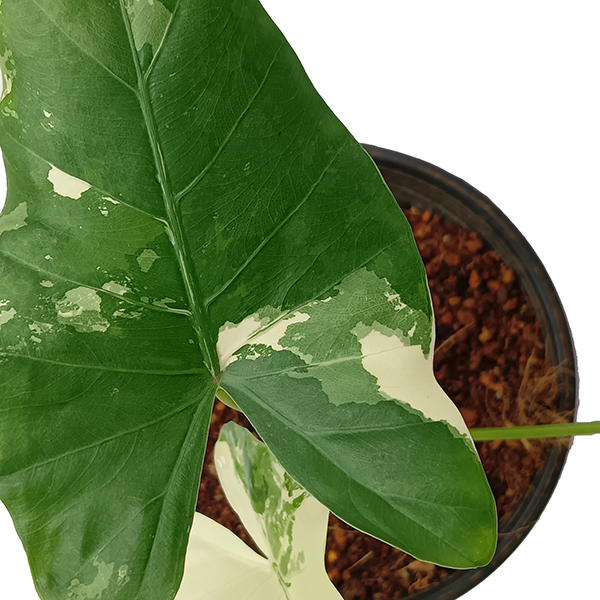
Common Name: Chinese Money Plant, Friendship Plant, Missionary Plant, Pancake Plant, UFO Plant
Botanical Name: Pilea peperomioides, Pilea Cadierei, Family: Urticaceae
The Pilea peperomioides goes by many aliases, most of which are inspired either by the appearance or history of the plant. Whatever name you use, you are sure to recognize the distinctive round, glossy foliage of this easy-care houseplant.
Pilea originally hailed from China, and later found their way to Scandinavia thanks to Norwegian missionaries. This plant is known to be so easy to propagate that owner’s typically end up gifting cuttings or new plants grown from offsets to friends and family.
This rare houseplant introduces a unique look and texture, ensuring effortless plant styling opportunities while requiring minimal care.
The Pilea cadierei, or commonly known as the Aluminum Plant have similar care to the Chinese Money Plant, but do require more water during the growing season ( when the plant is actively producing new foliage). The leaves a bit more tender and do not hold as much water in them compared to Pilea peperomiodies.
Pinch back leggy growth in order to keep a dense habit and to avoid having to stake up the foliage. These types of indoor plants respond very well to pruning!
Aluminum Plants benefit from fertilizing during the growing season. We recommend using 1/2 strength complete liquid fertilizer twice a month for optimal growth and health!
Light
The full, lush greenery of the Pilea is dependent on lots of indirect light. Medium or bright indirect light are best and will help the Pilea maintain its vivid green leaves and also help promote new growth. Direct light should be avoided as this can burn the leaves.
Periodically rotate your Pilea houseplant so all sides receive even light. This will create a more full plant and prevent the plant from becoming leggy or creating gaps in the greenery as a result of leaves reaching towards the light source.
Water
Water your Pilea peperomioides houseplant when the top several inches of the soil are dry to the touch. When it’s time to water, make sure to saturate the soil and let the water drain through the pot. The stems may droop when the plant is dehydrated, and if you water it right away the leaves should perk back up.
It’s completely normal for the Pilea to need less water during the winter. Continue to monitor the soil and water when the soil feels dry.
Temperature
Chinese Money Plants like to stay warm, and generally a comfortable room temperature is good for the plant, too. Ideally, Pilea peperomioides should stay between 60-80 degrees. Pilea don’t like temperature fluctuations or drafts, so avoid placement near heating or cooling vents, air conditioner units, and even exterior doors during the winter months.
A Pilea can make a nice addition to a shaded patio or outdoor space in the summer, but make sure to bring the plant back inside before the temperatures turn chilly.
Humidity
Keeping with their easy-care reputation, Chinese Money Plants can handle a range of conditions, but they prefer medium to high humidity. If the edges of the leaves begin to dry out that can be a sign that the Pilea needs more moisture in the air. It may be necessary to use a humidifier or a pebble tray with water during the winter months, especially in a dry climate.
Remember that humidity levels influence how often the plant needs to be watered. A Chinese Money Plant that lives in a humid environment may not need to be watered as often.
Fertilizer
Fertilize your Pilea during the warmer months to help your plant thrive and push out new growth. Use a fish or seaweed emulsion or a diluted complete liquid fertilizer every other week. It’s ok to hold off on fertilizing the plant during the colder months, especially if the Pilea is not actively growing.
Pro Tips
Use a damp cloth to clean the leaves if you notice dust buildup. Not only will this keep your Pilea looking its best, but clean leaves are better able to conduct photosynthesis.
Pilea peperomioides can be propagated through cuttings. Simply snip off a leaf and place the cut end in water. Roots should begin to form in a couple of weeks. Healthy Pilea will send out pups or offsets when they’re ready. These pups can be allowed to root in the pot with the mother plant or they can be removed and placed in soil or water to form roots.
Pilea flower! With proper care the houseplant will produce small, delicate, white flowers. You can wait until the flowers are done blooming to remove them. Or, you can remove the flowers right away in order to redirect energy and promote growth if the leaves are the real draw for you.





